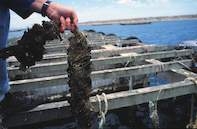
Mussel farming similar to agriculture and commonly referred to as aquaculture or mariculture. The farming season usually starts in early summer around November or December, and Blue Ocean Mussels leave their mussels untouched for about eight months before they are harvested.
For the first three weeks, mussel larvae will float around until choosing a suitable surface to settle on, from here the mussel will begin to grow a byssus thread.
Once the mussels have reached their preferred and marketable size of about 8cm they will undergo freezing and packaging processing the same day, in order to ensure the highest quality product reaches the plate. Often only half of these harvested mussels will actually undergo this process, the remaining half will be suspended to undergo another 8-month harvest cycle.
Mussels are commonly referred to as ‘Black Mussels’ due to their colour, however in South Africa, the Mytilus Galloprovincialis, which is colloquially known as the Mediterranean or Spanish mussel, is used for farming. This species of mussels are distinguished by the colour of the meat within the shell, male mussels being white and creamy and female mussels being orange in colour.
The Black Mussels type that is indigenous to South Africa has a black or blue coloured meat. It naturally settles on the ropes during the farming process and is scientifically known as Choromytilus Meridionalis. Blue Ocean Mussels begin harvesting mussels at 6 o’clock in the morning, ensuring that the freshest mussels reach South African plates.
 Mussel farming in South Africa is based on two mussel species, the indigenous black mussel and the exotic Mediterranean mussel....
Mussel farming in South Africa is based on two mussel species, the indigenous black mussel and the exotic Mediterranean mussel....